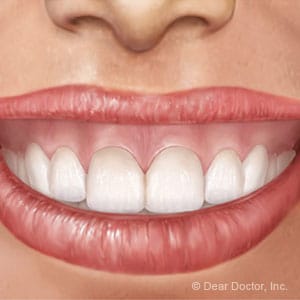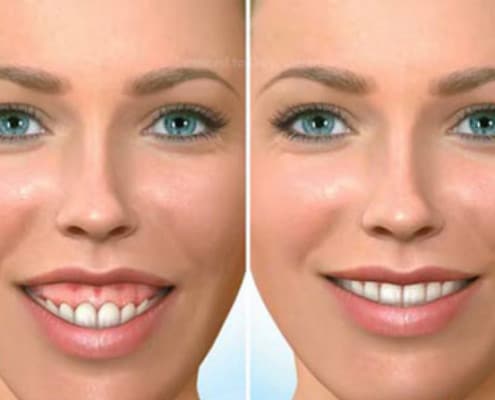how to fix a gummy smile
How to Fix a Gummy Smile: The Ultimate Guide to Gummy Smile Reduction
Correcting a gummy smile can be liberating for a patient. If you feel you have a gummy smile, you get it. When you smile and feel your gums are too big, it can haunt you. I know this because patients routinely tell me their gummy smile has been their single biggest source of self-consciousness. And it's not just a self-consciousness that is occasional, patients routinely confess that they have been embarassed to smile or laugh their entire life.
Let me say that again, people with gummy smiles often have been embarrassed to smile their whole life. No one needs to carry that burden.
Do you know what makes the embarrassment of a gummy smile even more ironic? Most people with gummy smiles have beautiful teeth! Talk about a psychological mind game for someone.
So what does a patient with a gummy smile do?
They begin to consciously try to hold their smile in certain positions to hide their gums. They even try to cover their mouth when they laugh. These methods help to compensate to help them feel more comfortable, but the insecurity still weighs on them. Can you imagine the bitter sweet feeling of being embarrassed every time you laugh in delight?
Well heres the thing, a lot of people understand that feeling. Everyone has something they are self-conscious about. Absolutely everyone. Do not feel alone and please do not feel shameful. For some people a gummy smile is their biggest insecurity. If you feel you have a gummy smile, please know that the feeling is common. Studies estimate that as many as 25% of the population are insecure about their gums when they smile.
Do you want to know the amazing thing about being embarrassed about your gummy smile?
It's an insecurity that can be improved. And when a gummy smile is improved, the insecurity is gone forever. I know this because as a nationally recognized gummy smile expert I have treated many patients who once felt their gummy smile was their biggest defect. When it comes to gums, I've seen it all.
And guess what? Patients that once hated their smile, no longer feel that unnecessary shame. In fact, their smile becomes one of their biggest assets. That is what I hope the same for anyone who feels insecure about their smile.
This article is meant as an ultimate guide to gummy smile reduction. It will tell you the causes, the treatments, and the hidden truths that all patients with a gummy smile feel they share as told by a gummy smile specialist who has seen it all first hand.
What Is a Gummy Smile?
An attractive smile is less about how the exact dimensions of the teeth and gums; and it's more about how the smile is in harmony with the entire face.
In an ideal smile, the upper lip sits just above the top of the teeth– usually about 0 to 2mm above the teeth to be exact.
A "gummy smile," however, exposes a larger than average amount of gum tissue. Whats the result? The smile creates visual disharmony of the overall facial proportions. As I talked about before, gummy smiles are common. The condition affects about 15% to 25% of the population with a greater percentage of young women from the ages of 15 to 35 being affected more than the rest.
What Causes a Gummy Smile?
The answer to the question , "What causes a gummy smile," may seem simple. I know what you're thinking, the cause is that there is too much gum. Come on, Dr. Sutera, it's obvious.
The reality is the cause of a gummy smile is much more complicated than that. Because there are a few different causes for a gummy smile, its important to see a specialist that understands each of the different reasons. Here's why it matters: treatment isn't cookie cutter; it depends on the cause. Each cause of a gummy smile dictates the treatment needed.
Now that you understand that, let's look at the three most common causes of a gummy smile. As always, I'll break each cause down and simplify so they are easy to understand. You've probably seen gummy smile causes stated much more technically. If you've read terms like delayed passive eruption or maxillary vertical excess, its all correct, but difficult to understand. Why would I give you the raw ingredients when I can cook it for you? I'm going to break down the causes down simply and easily so that there's no confusion.
Extra Gum (Gingiva) is Covering the Teeth

Too much gum covering the teeth is one of the most common causes of a gummy smile. The teeth are normal size; they are just hidden by extra gum . The teeth look short because they are partially covered. When the extra gingiva is sculpted and removed, the teeth look proper size and the gum display is reduced. For this condition I want you to think of a window with a shade on it. The window is normal size, but if the shade is stuck halfway down, you're only seeing half the window. The rest is hidden underneath.
The Lip Rises Higher than It Should

The upper lip is actually a series of several muscles. If the lip length and muscle strength are causing the lip to ride up higher than ideal, there will be excessive gums shown. The teeth may be normal height and the gums might be at normal height, but the lip is drawing back too far. For this condition, we'll use the window example again. Think of this condition as if the shade on the window was mounted too high, like on the ceiling instead of the top of the window. When you draw up the shade to the maximum height, it exposes not only the beautiful window but the wall above the window.
The Upper Jaw (Maxilla) is Taller than Ideal

Remember how we talked about facial harmony being important for evaluating a gummy smile? What you need to understand is that the ideal proportions of the face are 1/3 for the upper face (forehead), 1/3 for the mid face nose/maxilla, and 1/3 for the lower face (mandible/chin).
In some cases, during growth and development, some people have more growth in the mid face compared to the rest of the face. The techincal term for this is called vertical maxillary excess. The result is when the lip rises, there is more bone and gum underneath. For our window analogy, think of a window that has an extra wide structural frame. When a normal length shade (in this case, the lip) is pulled up, its too short. You will see more of the window frame than ideal.
Is a Gummy Smile A Cosmetic or Functional Concern?
When we talk about a gummy smile, what we are really discussing is what dentists call the smile line or esthetic zone – the teeth that are showing when you are smiling. The smile line is determined by several factors, including:
- The shape and size of your lips.
- Your facial muscles.
- The skeletal proportions of your face
- The shape and size of your teeth.
- The amount and thickness of your gum tissue (gingiva).
The optimal smile line appearance is usually about 0-2mm from the top of the teeth and it should be level to the eyes. It is important to note that the symmetry of the gumline is equally important to the height when considering cosmetics.
We talked about cosmetics of a gummy smile, but can a gummy smile be a functional issue? In most cases, no. There is usually no functional concern with a gummy smile. Therefore, if a person has a gummy smile and is happy with the aesthetics, there usually is no need for treatment.
So when does a gummy smile pose a health concern?
There are very limited and rare situations in which a gummy smile can be a sign of a medical condition. The first is when there is an orthodontic functional issue that is along with the gummy smile. In some cases the gummy smile is associated with a skeletal and orthodontic disharmony that interfers with the ability to chew.
The second situation is when the gums begin to grow suddenly when they were previously normal. The condition is called gingival hyperplasia. Some examples of conditions that cause gingival hyperplasia are if the gums are severely inflamed due to bacteria, if the gums are growing due to a medication the person is taking, or if there is an underlying uncontrolled systemic health condition like diabetes, leukemia, or HIV which all can cause the gums to grow and inflame suddenly.
Are You a Candidate to Fix a Gummy Smile?
Gum smile reduction is ideal for patients who are dissatisfied with the appearance of their gums and teeth. If your gums show more than you like when you smile, or if your teeth appear short or small due to your gums, then gummy smile reduction may be able to give you the smile you want.
The best and most common candidates for gummy smile reduction:
- Have been unhappy with the appearance of their gummy smile
- Understand the risks and rewards of fixing a gummy smile
- Have realistic expectations
- Have healthy gums and teeth
- Practice good oral hygiene
Some general dentists may be able to treat your condition, but not all do. Your dentist may refer you to a specialist, like a periodontist, orthodontist, oral surgeon, or a gummy smile national expert like myself, Dr. Sutera on the east coast, or Dr. Farnoosh on the west coast.
If you've been concerned about your gum display for a long time, please know that there are many gummy smile treatments available. And now, we'll talk about them.
Steps to Correct a Gummy Smile

Consultation with a Gummy Smile Specialist
The first step of correcting a gummy smile is research. That's what you're doing right now. You are familiarizing yourself with the information you need to know to succeed. So Bravo. You already completed the first step.
The next step is to have a consultation with a gummy smile specialist. At the consultation, you can expect the gummy smile specialist to listen to your concerns and goals, examine your smile, take pictures of your smile, review x-rays, and discuss options available. The gummy smile expert may also be able to digitally simulate the outcome of the procedure for you depending on your case. From then its up to you. Let's discuss some of the treatments a specialist may present to you.
Treatments for Gummy Smiles
Gum Lift (also known as Gingivectomy or Crown Lengthening)
A gum lift involves removing a portion of the gum tissue around a tooth and placing the gumline into a higher position. When the amount of gum removal is mild to moderate, the procedure can be accomplished with a procedure called a gingivectomy.
Essentially a gingivectomy means the removal of gum tissue. Hence the name, "gingiva" which means gum and "ectomy" which means to remove.
When the amount of gum tissue is more severe, it may accomplished by a procedure called crown lengthening. Crown lengthening is similar to a gingivectomy, but involves the sculpting of the area around the tooth to achieve proper results, which means adjusting the gum and the bone around the teeth to the proper level.
For most cases, the healing for a gum lift is generally around 1-3 days of mild swelling and tenderness. The full results are generally observed in about 1 week after the procedure for a gummy smile reduction by a gingivectomy. For more complex gummy smile reduction with crown lengthening the final results may be observed in 4-6 weeks, and sometimes may be combined with dental veneers.
Lip Repositioning (also known as Lip Lowering Surgery or Reverse Vestibuloplasty)
For lip lowering surgery, it's a bit of a misnomer. The exterior part of the lip is not actually lowered or even affected. The procedure for gummy smile reduction by lip lowering involves making two incisions at the gumline under the lip. A small band of gum tissue is removed and the gum tissue is sutured to a lower position. The result, when the person smiles the lip won't rise as high in full smile.
There are no changes to the lip or face other than reducing the height of the smile. Occasionally patients may comment that they feel their lips look slightly more full which most patients consider an added benefit of the procedure.
The healing for lip repositioning for a gummy smile is about 2 weeks of mild to moderate discomfort. There may be bruising that resolves around the first week. The key for success with lip lowering surgery is that the patient must refrain from smiling for 4 weeks while the procedure heals. By not smiling or straining the lips during the 4 weeks after the procedure, it allows the smile to heal proper at the level the surgeon positioned it.
The final results for lip lowering surgery generally are observed at 4 weeks after surgery, and there may be some minor settling up to about 6 months.
Botox for Gummy Smile Correction
Botox helps to fix a gummy smile by relaxing the muscles of your upper lip. The upper lip is actually a series of muscles, and what botox does is reduce muscle activity. So by injecting a small amount of botox in the muscle that raises the lip it reduces how high your lip goes when you smile.
The results of the Botox injection will be fully visible within 4-7 days, and results can last 4-6 months. Botox can be re-injected as needed once its effects wear off.
The benefit of Botox is that it is reversible and allows a patient to test how their smile looks before surgery, however, that is also the biggest disadvantage. Botox for a gummy smile can be costly over the course of a lifetime to continually invest in treatments.
Orthodontics (braces or invisalign)
Sometimes a gummy smile can be less of a true problem and more of a mirage based on the position of the teeth. If the teeth are aligned in a position that draws attention to an assymetrical gumline, it is sometimes possible to correct a gummy smile by orthodontics. As the teeth move into an improved position, the gumline will also follow. In some cases orthodontics may improve the gummy smile enough for the patient to be comfortable, or orthodontics may be an initial step prior to other treatment.
Gummy Smile Jaw Surgery (also known as Orthognathic Surgery)
The final option for correcting a gummy smile is known as orthognathic surgery. This procedure is the most complex of all we have talked about, but you will be comforted to know that it is also the least commonly required. Think like in terms of less than 5% of all gummy smiles.
Orthognathic surgery is required when there is a severe discrepancy of the downward growth of the top jaw, the maxilla. The surgery involves adjusting the position of the jaw to a higher position. You can consider orthognatic surgery similar to plastic surgery but with a functional dental component. If a patient is unhappy with the length of their face as well as their smile, or if they have a severe orthodontic condition, we may consider orthognathic surgery.
However, as I said, don't get too ahead of yourself and think you need the most complex surgery to correct a gummy smile. In terms of gummy smile correction by itself, orthognathic surgery is generally not a common recommendation compared to the other options.
Which Treatment Do I need to Correct a Gummy Smile?
We talked about a lot of what causes a gummy smile and what treatments reduce a gummy smile. It's only natural for you to wonder, which treatment do I need to correct my gummy smile? I'll help to narrow it down and match the common causes of a gummy smile to which treatments are most often considered for each cause. Here we go:
1) Too Much Gum over the Teeth: Gingivectomy or crown lengthening are the treatments most commonly considered to correct big gums over the teeth that make the teeth look short.
2) The Lip Rises too High: Lip lowering surgery is best for permanent correction if your lip rises too high when you smile or you could consider Botox for a more temporary option.
3) The Upper Jaw is Too Long: If the maxilla is skeletally too long but the orthodontics are generally able to function adequately, lip lowering surgery can improve a gummy smile. If the maxilla is long and the top and bottom jaw orthodontically do not align, orthognathic surgery is often a better option.
How Much Does Gummy Smile Correction Cost?
The cost for gummy smile correction can vary based on the treatment that is required and the severity of the case. You will also have to weigh the pros and cons of the different options in terms of how permanent they are. For example, Botox may be more affordable for one treatment compared to other options, but Botox needs to be repeated every 4-6 months to maintain the results. Other options will generally be more permanent, essentially a one and done procedure.
Botox injections for a gummy smile can cost between $200 to $600 per treatment, and generally need to be repeated a couple times per year. Gingivectomy also called a gum lift for the entire top arch can cost anywhere between $1000-$2500 to correct a gummy smile. Lip repositioning or lip lowering can cost anywhere between $1800 to $4000.
Depending on the complexity of the case, the cost for gummy smile treatment could involve bundling two or more procedures to achieve the most ideal result. Generally when a gummy smile reduction requires more than one treatment, the cost can be presented as bundle which helps to lower the cost compared to the treatment individually.
Keep in mind that gummy smile surgery is an investment in yourself. There are options to help make your investment more affordable. Some financing options available are through Care Credit, the Lending Club, Flex Spending Accounts, and Health Savings Accounts.
How Gummy Smile Correction can Affect your Life
The benefits of improving your smile extend much deeper than vanity. When someone has any insecurity in their life it can be life changing to relieve them of that burden. Improving your smile can improve confidence, self esteem, and allow you to be the best version of yourself. Gummy smile treatment may provide one or more of the following improvements:
- Allow your teeth to be the focal point of your smile
- Expose more teeth, symmetrically, and evenly
- Improve confidence when you've always been embarrassed to smile
- Enhance fullness of the upper lip
- Create a smile that looks natural, relaxed, and sincere
- Achieve harmony and balance between your smile and the rest of your face
Reveal the Beautiful Smile that You Already Have
The fact of the matter is that you've already one. By reading articles like this you are showing that you believe in yourself. And you are trying to make improvements in your life. If you made it this far in the article, you are nearly an expert in understanding how to fix a gummy smile.
The point I want to leave you with is this: Everyone can make an improvement at something in their life. If you have been bothered by what you feel is a gummy smile, you should know that there are options available. You're able to not only improve your confidence in your smile but also be the best version of yourself.

how to fix a gummy smile
Source: https://www.aestheticsmilereconstruction.com/2020/05/19/how-to-fix-a-gummy-smile-the-ultimate-guide-to-gummy-smile-reduction/
Posted by: thomaspring1974.blogspot.com


0 Response to "how to fix a gummy smile"
Post a Comment